Pallippuram
or Palliport is at the northern end of the Vypeen Island at Cochin about 2 km off the main
road. This temple was established in 1881 AD. The main deities are Lakshmi
Narayana and Raghupati.
There are also the images of Balakrishna and
Hanuman in this temple. Presently, the temple is under direct control of Kashi mutt. |

The new temple front view
|
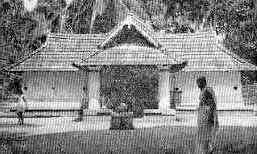
A view of old temple
|

Lakshminarayana
|
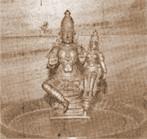
Raghupati
|
History
The temple originally belonged to the Koudinya
Gotra Kamat family of Vypeen who were Ayurveda Practitioners. They migrated to
Pallipuram in 1867 AD, after the large scale sea erosion in Azheekal. They carried with
them the idol of Lakshmi Narayana, given to them by Sumathindra Tirtha Swamiji of Kashi
Mutt and worshiped in their house. Later in 1881 AD, a temple was constructed and
prathista was done.
 Sri Bhuvanendra Tirtha, the 17th Pondiff of Kashi
Mutt was born in this family in 1837 AD. He was initiated to Sanyasa in 1851 AD at the
early age of 13 years. He too was proficient in Ayurveda. It was Swami Bhuvanedra Tirtha
who handed over the management of the temple to the Kamath family under a deed executed in
the year 1882 AD. However, Sri Ramachandra Kamath, a great Ayurveda Physician of the Kamat
family, entrusted the management of the temple with its properties to Kashi mutt samsthan
in 1980 AD. A branch of Kashi mutt samsthan was established here. The temple was renovated
as ordained by Sri Sudheendra Tirtha Swamiji. He also did the puna-prathista and
re-installation of the deity in 1991 AD. A community Hall Bhuvanendra
Kalamandir on the left side of the temple was inaugurated on that occasion. A
public hall for the devotees (Sudheendra Sabha Sadan) has been later constructed adjacent
to the temple premises. Sri Bhuvanendra Tirtha, the 17th Pondiff of Kashi
Mutt was born in this family in 1837 AD. He was initiated to Sanyasa in 1851 AD at the
early age of 13 years. He too was proficient in Ayurveda. It was Swami Bhuvanedra Tirtha
who handed over the management of the temple to the Kamath family under a deed executed in
the year 1882 AD. However, Sri Ramachandra Kamath, a great Ayurveda Physician of the Kamat
family, entrusted the management of the temple with its properties to Kashi mutt samsthan
in 1980 AD. A branch of Kashi mutt samsthan was established here. The temple was renovated
as ordained by Sri Sudheendra Tirtha Swamiji. He also did the puna-prathista and
re-installation of the deity in 1991 AD. A community Hall Bhuvanendra
Kalamandir on the left side of the temple was inaugurated on that occasion. A
public hall for the devotees (Sudheendra Sabha Sadan) has been later constructed adjacent
to the temple premises.
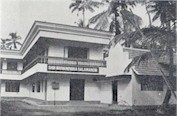
Bhuvanendra Kalamandir
|
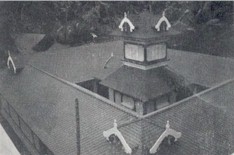
Aerial view of New Temple
|
The temple has a five day long annual festival in
the month of Magha.

A view of the temple from right side of the temple

Front view of the temple - Bhuvanendra kalamandir on the right

Entrance to temple from public road
Temple at far end and Sree Sudheendra Sabha Sadan on the right side
More about Pallipuram
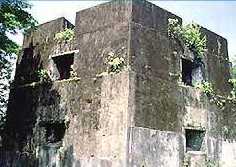 Pallippuram is an attraction for historians and pilgrims. The Pallippuram
Fort built by the Portuguese in 1503 AD, is considered to be the first fort built in
India by the Europeans. The hexagonal shaped fort has three storeys and is now a protected
monument. The Dutch captured the fort in 1661 AD and sold it to the State of Travancore in
1789 AD. Pallippuram is an attraction for historians and pilgrims. The Pallippuram
Fort built by the Portuguese in 1503 AD, is considered to be the first fort built in
India by the Europeans. The hexagonal shaped fort has three storeys and is now a protected
monument. The Dutch captured the fort in 1661 AD and sold it to the State of Travancore in
1789 AD.
 The Forane
church of Lady of Snow (which belongs to Diocese of Kottapuram) at Pallippuram is an
important pilgrim center of the Christians. In 1577 AD, the church was built in Portuguese
style. It is believed that when Tipu Sultan came from Mysore with his armours,
destroying the churches and all things made by the Portuguese, reached Pallippuram,
the nearby people gathered in the Church and prayed to Mother Mary. Then the place was
covered with fog and he retreated. The Forane
church of Lady of Snow (which belongs to Diocese of Kottapuram) at Pallippuram is an
important pilgrim center of the Christians. In 1577 AD, the church was built in Portuguese
style. It is believed that when Tipu Sultan came from Mysore with his armours,
destroying the churches and all things made by the Portuguese, reached Pallippuram,
the nearby people gathered in the Church and prayed to Mother Mary. Then the place was
covered with fog and he retreated.
Pallipuram is reachable
from Vypeen by bus. Vypeen is connected by ferry with Fort Cochin and Ernakulam.
This place is often called North Pallipuram since there is
another Pallipuram towards south of Cochin near Shertallai.
|
